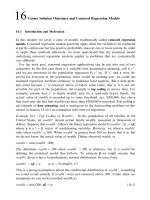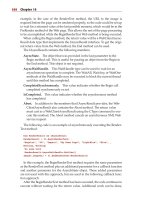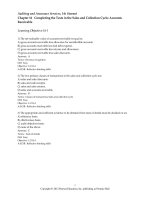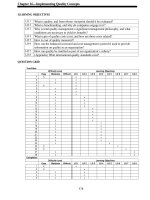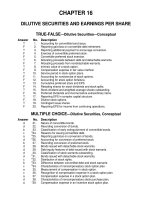BOM chapter 16 edited by duyen nguyen
Bạn đang xem bản rút gọn của tài liệu. Xem và tải ngay bản đầy đủ của tài liệu tại đây (9.11 MB, 55 trang )
CHAPTER 16
Motivating Employees
Edited by Duyen Nguyen – Lecturer at VNUIS
CRITICAL THINKING
Question 2
Do you like being a
freelancer? Why?
autonomy: tự chủ
Question 3
Some people live to
work, and others work to
live. How about you?
Question 4
Question 5
What are the elements
that make a job
worthwhile?
Are you a
procrastinator ?
người hay chần chừ
Question 1
Question 6
Do you like to have 9to-5 job? Why?
What motivates you
in life ?
What motivates you in life ??
Things and people that keep you motivated
Family
Family - 98%
Job - 59%
Friends - 78%
Success - 56%
Peers - 19%
????
Job
Friends
Success
Peers
0
25
50
75
100
How would you generally feel, happy or unhappy , if
you were in the following situations?
How would you generally feel, happy or unhappy , if
you were in the following situations?
hoa hồng
cơng đồn
ép từ chức
tiềm năng
thiếu động lực và
sáng kiến
OUTLINE
I. The Concept of Motivation
II. Content Perspectives on Motivation: Hierarchy of Needs Theory;
ERG Theory; Two-Factor Theory; Acquired Needs
III. Process Perspectives on Motivation: Goal-Setting Theory; Equity
Theory; Expectancy Theory;
IV. Reinforcement Perspective on Motivation: Reinforcement Tools;
Schedules of Reinforcement
V. Social Learning Theory
VI. Job Design for Motivation: Job Simplification; Job Rotation; Job
Enlargement; Job Enrichment; Job Characteristics Model
VII. Innovative Ideas for Motivating: Empowering People to Meet
Higher Needs; Giving Meaning to Work through Engagement
Learning Objectives
Define motivation and explain
the difference between
intrinsic and extrinsic rewards.
Describe reinforcement
theory and how it can be
used to motivate
employees.
Identify and describe content
theories of motivation based
on employee needs.
Discuss major approaches
to job design and how job
design influences motivation
Identify and explain process
theories of motivation
Explain how empowerment
heightens employee
motivation.
Identify three elements of employee engagement and ways to create a
work environment that promotes engagement.
MOTIVATION
Is the arousal of enthusiasm and persistence to pursue a certain course of action
One secret for success in
organizations is motivated
and enthusiastic
employees
Employee motivation
affects productivity
The challenge is to keep
employee motivation
consistent with
organizational goals
Part of a manager’s job is to
channel motivation toward the
accomplishment of
organizational goals
I. Two Types of Rewards
Two types of motivation
Motivation
Description
Example
Money
Extrinsic
Satisfactions a person
receives in the process of
performing a particular action
Praise
Awards
Joy
Intrinsic
Given by another person
Belief
Achievement
I. A Simple Model of Motivation
REWARDS-Satisfy
NEED-Creates desire to fulfill BEHAVIORResults in actions needs; intrinsic or
needs (food, friendship,
to fulfill needs.
extrinsic rewards.
recognition, achievement).
FEEDBACK-Reward informs person whether behavior was appropriate
and should be used again.
Motivation theories
Content theories
•Stress the analysis of underlying human needs and how
needs can be satisfied in the workplace
Process theories
•Concern the thought processes that influence behavior
Reinforcement theories and social learning
• Focus on employee learning of desired work behaviors
II. Content Theories of Motivation
Emphasize the needs that motivate people
vHierarchy of Needs Theory: Maslow
v ERG Theory: Clayton Alderfer
v Two-Factor Theory: Henry Herzberg
v Acquired Needs Theory: David McClelland
II. Content Theories of Motivation
Maslow’s hierarchy of needs
Self-actualization
Development needs
Esteem
Respect, recognition
Belonging
Friendship, caring
Safety
Security, stability,
health
Physiological
Food, sleep, air, water
Maslow’s Hierarchy of Needs
Maslow’s Hierarchy of Needs
• Once a need is satisfied, it declines in
importance and the next higher need is activated
• There are opportunities for fulfillment off the job
and on the job in each of the five levels of needs
ERG theory (Clayton Alderfer)
• ERG theory: A modification of needs hierarchy theory that
proposes three categories of needs: existence, relatedness, and
growth
• Frustration-regression principle: The idea that
failure to meet a high-order need may cause a regression to an
already satisfied lower-order need.
ERG theory
Growth Needs
human potential,
personal growth, and increased
competence
Relatedness Needs
the need for satisfactory relationships
with others
Existence Needs
the needs for physical well-being
Area of Satisfaction
Motivators
Achievement
Recognition
Responsibility
Work itself
Personal growth
Motivators
influence
level of
satisfaction.
Area of Dissatisfaction
Hygiene
Factors
Working conditions
Pay and security
Company policies
Supervisors
Interpersonal
relationships
Hygiene factors
influence level of
dissatisfaction
Two Factor Motivation
Theory
( Henry Herzberg)
Acquired Needs Theory
David McClelland
• Need for Achievement desire to accomplish something
difficult, master complex tasks, and surpass others
• Need for Affiliation desire to form close personal
relationships, avoid conflict, and establish warm
friendships
• Need for Power desire to influence or control others
III. Process Theories of Motivation
vGoal-Setting Theory: Edwin Locke & Gary Latham
vEquity Theory: Stacy Adams
vExpectancy Theory: Victor Vroom
Goal Setting Theory
A motivation theory in which specific
challenging goals increase motivation and
performance when the goals are accepted
by subordinates and these subordinates
receive feedback to indicate their
progress toward goal achievement.
●
24
11/29/22
Key components of goalsetting theory
ü
Goal specificity: concrete & unambiguous goals
ü
Goal difficulty: with challenges
ü
Goal acceptance: commitment, acceptance,
participation
ü
Feedback: information about the individual’s
work, about goal achievement
25
11/29/22
Equity Theory
ü
ü
ü
focuses on individuals’ perceptions of how fairly they are
treated compared with others
motivated to seek social equity in the rewards they expect for
performance
A state of equity exists whenever the ratio of one person’s
outcomes to inputs equals the ratio of another’s outcomes to
inputs

